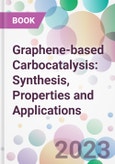This book informs readers about recent advances in graphene carbocatalysis encapsulating the current developments in the syntheses, properties, characterizations, functionalization, and catalytic applications of graphene, its derivatives, and composites. It serves as a comprehensive primary reference book for chemistry and engineering students who are required to learn about graphene chemistry in detail. It also serves as an introductory reference for industry professionals and researchers who are interested in graphene research as well as its emerging applications in catalysis and beyond.
Volume 2 presents information about the industrial applications of graphene-based materials. It starts with graphene-based photocatalysis and progresses into the electrochemical applications of related materials. Highlighted applications in this domain include the use of graphene for hydrogen production and in electrodes for electrochemical sensors. It also covers developments in graphene-based smart energy materials. The final chapter of the volume summarizes the future of graphene-based material technology.
Table of Contents
Chapter 1 Introduction to Photocatalysis
- Graphene, Graphene Oxide and Reduced Graphene Oxide
- Waste Water Treatment
- Graphene
- Dyes
- Drugs
- Metal
- Graphene Oxide
- Dye
- Drugs
- Reduced Graphene Oxide
- Dyes
- Drugs
- Metal
- Photogeneration of Hydrogen
- Graphene
- Reduced Graphene Oxide
- Reduction of Carbon Dioxide
- Graphene
- Graphene Oxide
- Reduced Graphene Oxide
- Others
- Graphene
- Graphene Oxide
- Reduced Graphene Oxide
- Some Recent Developments
- Conclusion
- Consent for Publication
- Conflict of Interest
- Acknowledgements
- References
Chapter 2 Electrocatalysis by Graphene Materials
- Introduction
- Principle and Mechanism of Electrocatalysis
- Hydrogen Evolution Reaction (Her)
- Oxygen Evolution Reaction (Oer)
- Hydrogen Oxidation Reaction (Hor)
- Oxygen Reduction Reaction (Orr)
- Graphene-Based Electrocatalysts
- Doping of Graphene With Non-Metallic Heteroatoms
- Doping With Boron (B)
- Doping With Nitrogen (N)
- Doping With Sulfur (S)
- Doping With Phosphorous (P)
- Graphene-Based Heterostructures
- Doped Graphene-2D Heterostructures
- Graphene-Plasmonic Nanostructured Electrocatalysts
- Conclusion and Future Prospects
- Consent for Publication
- Conflict of Interest
- Acknowledgements
- References
Chapter 3 Modified Graphene-Based Compound: Hydrogen Production Through Water Splitting
- Introduction
- Graphene: a Material With Enormous Possibilities
- Graphene: a Plasmonic Metamaterial
- Modification of Graphene
- Graphene Oxide (Go)
- Synthesis of Go
- Brodie’S Method
- Hummers' Method
- Tang’S Method
- Different Roles of Go in Catalysis
- Charge Separation and Gap Narrowing
- Go for P-N Heterojunction Formation or as An Electron Sink
- Go as a Surfactant for Nanoparticle Segregation and Dispersion in Water
- Go as An Electron Transport Mediator to Facilitate Charge Separation
- Go as a Redox Mediator to Facilitate Overall Water Splitting
- Reduced Graphene Oxide (Rgo)
- Synthesis of Rgo
- Criteria for Determining the Effect of Reduction of Go
- Visual Characteristics
- Electrical Conductivity
- Carbon to Oxygen Atomic Ratio (C/O Ratio)
- Removal of Functional Group on Reduction
- Number of Layers Determine by Scherrer Equation
- Optical Properties
- Absorption of Co2 and H2 by Graphene
- Graphene Oxide Quantum Dots
- Giant Red-Edge Effect
- Graphitic Materials for Hydrogen Generation Through Water Splitting
- Why Nano Forms of Materials Effective for Water Splitting
- Category of Graphene-Based Compounds for Water Splitting
- Pure Graphene Systems
- Binary Systems
- Sic/Rgo
- Ternary Go-Based Systems
- Conclusion
- List of Abbreviations
- Consent for Publication
- Conflict of Interest
- Acknowledgements
- References
Chapter 4 Graphene-Based Smart Energy Materials for Fuel and Solar Cell Applications
- Introduction
- Graphene
- Graphene and Graphene Oxide (Go) for Fuel Cell Applications
- Graphene Oxide (Go) Based Membranes in (Pemfcs)
- Synthesis and Functionalisation of Graphene for Solar Cell Applications
- Graphene in Organic Photovoltaic Cells (Opvs)
- Graphene-Based Dye Sensitiser Solar Cells (Dsscs)
- Conclusion and Future Challenges
- List of Abreviations
- Consent for Publication
- Conflict of Interest
- Acknowledgements
- References
Chapter 5 Graphene-Based Electrodes for Electrochemical Sensors
- Introduction
- Graphene
- Structures, Morphology, and Optical Properties of Graphene
- Electrocatalysis
- Graphene-Based Electrocatalysis
- Intrinsic Defect
- Doping of Non-Metals
- Graphene Composite
- Graphene-Based Single-Atom-Catalyst
- Graphene Electrochemistry
- Electrochemical Sensors (Ecs)
- Types of Electrochemical Sensors
- Potentiometric Approach
- Voltammetric Approach
- Amperometric Detection Approach
- Impedimetric Detection
- Conductometric Approaches
- Conclusion
- List of Abbreviation
- Consent for Publication
- Conflict of Interest
- Acknowledgements
- References
Chapter 6 State-Of-The-Art Graphene Carbocatalysis and Future Challenges
- Introduction
- Conclusion
- Consent for Publication
- Conflict of Interest
- Acknowledgements
- References
- Subject Index
Author
- Pinki Bala Punjabi
- Sharoni Gupta
- Rakshit Ameta








